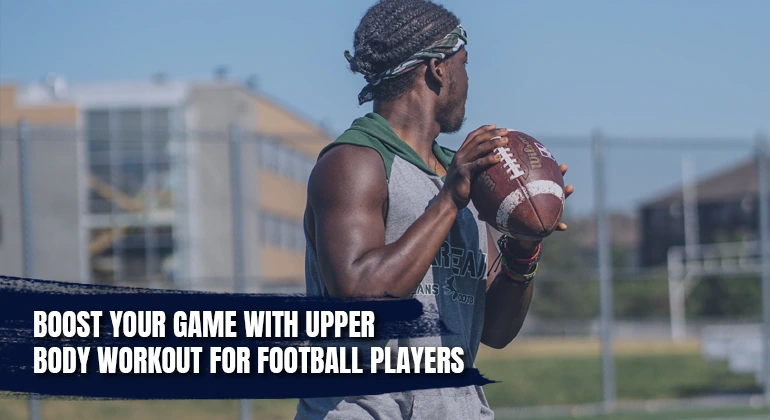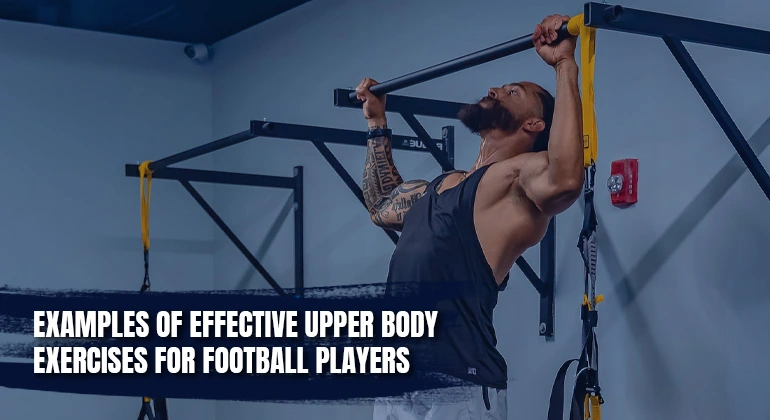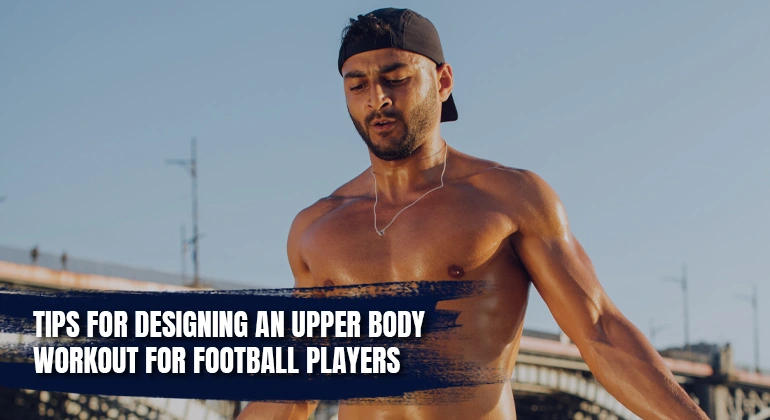
Football is a high-impact sport that demands a combination of strength, speed, agility, and endurance. While training the lower body is essential, many players tend to overlook the importance of upper body training. However, a strong upper body can help football players excel on the field, from breaking tackles and powering through blocks to throwing the ball further and catching it more efficiently.
In this blog post, we will explore the benefits of incorporating an upper body workout routine into your football training program. We will cover the key muscle groups that football players should focus on, such as the chest, back, shoulders, and arms, and provide examples of exercises that target these areas effectively. Additionally, we will discuss how upper body training can improve your overall performance, including your speed, power, and coordination.
Whether you are a seasoned football player or just starting out, our guide to upper body workout for football players will help you take your game to the next level. So, are you ready to enhance your game and dominate on the field? Let's dive in and explore the world of upper body training for football players!
Read about: Discover Khalil Mack Workout for Building Strength
Importance of Upper Body Training for Football Players
Upper body training is crucial for football players because it helps to improve their overall performance on the field. Football is a high-impact sport that demands a injectable steroids for bodybuilding combination of strength, speed, agility, and endurance. While training the lower body is essential for mobility and explosive power, many players tend to overlook the importance of upper body training.
A strong upper body can help football players excel on the field, from breaking tackles and powering through blocks to throwing the ball further and catching it more efficiently. Upper body strength is especially important for players in certain positions, such as quarterbacks, wide receivers, and defensive linemen, who need to have strong arms, shoulders, and chest muscles.
Additionally, upper body training can improve a player's speed, power, and coordination. Exercises that target the upper body can help to build explosive power, which is essential for tackling, throwing, and blocking. Upper body training can also help to improve coordination and control, which can lead to better balance and stability on the field. Furthermore, having a strong upper body can help players to maintain their endurance and stamina throughout the game, reducing the risk of injury and fatigue.
Key Muscle Groups to Target
There are several key muscle groups that football players should focus on when incorporating upper body training into their workout routine. These include the chest, back, shoulders, and arms.
- Chest Muscles: The chest muscles are essential for pushing movements such as blocking and tackling. Some effective exercises to target the chest muscles include the bench press, push-ups, and chest flys.
- Back Muscles: The back muscles are important for pulling movements such as reaching for a ball or pulling an opponent down. Effective exercises to target the back muscles include pull-ups, chin-ups, and rows.
- Shoulder Muscles: The shoulder muscles are important for throwing and catching the ball and for supporting the arms during blocking and tackling. Effective exercises to target the shoulder muscles include shoulder press, lateral raises, and reverse flys.
- Arm Muscles: The arm muscles are important for throwing, catching, and gripping the ball, as well as for blocking and tackling. Effective exercises to target the arm muscles include bicep curls, tricep extensions, and hammer curls.
By targeting these key muscle groups, football players can build a strong and resilient upper body that will help them to perform better on the field. It's important to note that incorporating a variety of exercises that target each muscle group is crucial for achieving a well-rounded upper body workout routine.
Examples of Effective Upper Body Exercises for Football Players

Bench press
The bench press is one of the most effective upper body exercises for football players. It primarily targets the chest muscles, but also engages the shoulders and triceps. The bench press can be performed using a barbell or dumbbells and can be done on a flat, incline, or decline bench.
To perform a bench press, lie down on the bench with your feet firmly planted on the ground. Grip the bar with your hands slightly wider than shoulder-width apart and lower the bar to your chest, making sure to keep your elbows tucked in. Push the bar back up to the starting position, exhaling as you go.
The bench press is a compound exercise that can help to build strength and power in the chest muscles, which is essential for blocking and tackling. It also engages the shoulders and triceps, which can help to improve overall upper body strength and stability.
Pull-ups and chin-ups
Pull-ups and chin-ups are excellent exercises for building upper body strength and improving overall muscle definition. They primarily target the back muscles, but also engage the biceps and shoulders. Pull-ups are performed with an overhand grip, while chin-ups are performed with an underhand grip.
To perform a pull-up or chin-up, grab onto a horizontal bar with your hands slightly wider than shoulder-width apart. Hang from the bar with your arms fully extended, then pull yourself up until your chin is above the bar. Lower yourself back down to the starting position and repeat.
Pull-ups and chin-ups are challenging exercises that can help to build upper body strength and improve overall muscle definition. They primarily target the back muscles, which are essential for pulling movements such as reaching for a ball or pulling an opponent down.
Push-ups
Push-ups are a classic upper body exercise that primarily target the chest muscles, but also engage the shoulders and triceps. They can be done anywhere and require no equipment, making them a convenient exercise for football players who may not have access to a gym.
To perform a push-up, start in a plank position with your hands slightly wider than shoulder-width apart. Lower yourself down until your chest is just above the ground, keeping your elbows tucked in. Push yourself back up to the starting position, exhaling as you go.
Push-ups are a simple yet effective exercise that can help to build upper body strength and improve overall muscle endurance. They primarily target the chest muscles, which are essential for pushing movements such as blocking and tackling.
Shoulder press
The shoulder press is a compound exercise that primarily targets the shoulder muscles, but also engages the triceps and upper chest muscles. It can be performed using dumbbells or a barbell and can be done seated or standing.
To perform a shoulder press, start with the weights at shoulder level, palms facing forward. Press the weights overhead, making sure to keep your elbows tucked in. Lower the weights back down to shoulder level and repeat.
The shoulder press is an effective exercise for building shoulder strength and stability, which is essential for throwing and catching the ball and for supporting the arms during blocking and tackling.
Bicep curls
Bicep curls primarily target the biceps muscles, but also engage the forearms and shoulders. They can be performed using dumbbells, barbells, or resistance bands.
To perform a bicep curl, start with the weight in your hand, palms facing forward. Curl the weight up towards your shoulder, keeping your elbows tucked in. Lower the weight back down to the starting position and repeat.
Bicep curls are an effective exercise for building bicep strength and definition, which is essential for throwing, catching, and gripping the ball, as well as for blocking and tackling.
Tips for Designing an Upper Body Workout for Football Players

Designing an effective upper body workout routine is essential for football players who want to improve their performance on the field. Here are some tips for creating a workout routine that targets the key muscle groups and builds strength, power, and endurance:
- Set goals and track progress: Before starting a workout routine, it's important to set specific goals for what you want to achieve. This can help to keep you motivated and on track. Keep track of your progress by recording your weights, reps, and sets for each exercise.
- Choose the right exercises and weights: When designing an upper body workout routine, it's important to choose exercises that target the key muscle groups discussed earlier. Start with lighter weights and gradually increase the weight as you build strength and endurance.
- Vary workouts and challenge yourself: To avoid hitting a plateau and to continue seeing progress, it's important to vary your workouts and challenge yourself with new exercises and heavier weights. Incorporating different types of exercises, such as compound movements and isolation exercises, can also help to keep your workouts interesting and effective.
- Balance upper body and lower body training: While upper body training is important for football players, it's also crucial to balance it with lower body training. Make sure to incorporate lower body exercises, such as squats and lunges, into your workout routine.
- Rest and recover: Rest and recovery are essential for allowing your muscles to repair and grow. Make sure to take rest days and prioritize sleep and nutrition to support your recovery.
By following these tips, football players can design an effective upper body workout routine that targets the key muscle groups, builds strength and endurance, and improves overall performance on the field. Remember to always consult with a healthcare professional before starting any new exercise routine.
Conclusion
In conclusion, incorporating an upper body workout for football players can have a significant impact on a player's overall performance on the field. By targeting key muscle groups such as the chest, back, shoulders, and arms, football players can build a strong and resilient upper body that will help them to excel in their positions and enhance their game.
Effective upper body exercises such as bench press, pull-ups, push-ups, shoulder press, bicep curls, and tricep extensions can help to build strength, power, and endurance in the key muscle groups. It's important to balance upper body training with lower body training, vary workouts, challenge oneself, and prioritize rest and recovery to achieve the best results.
Overall, incorporating an effective upper body workout routine into a football training program can help players to improve their speed, power, agility, and coordination, reduce the risk of injury, and ultimately dominate on the field. By following the tips and strategies outlined in this guide, football players can take their game to the next level and achieve their full potential.